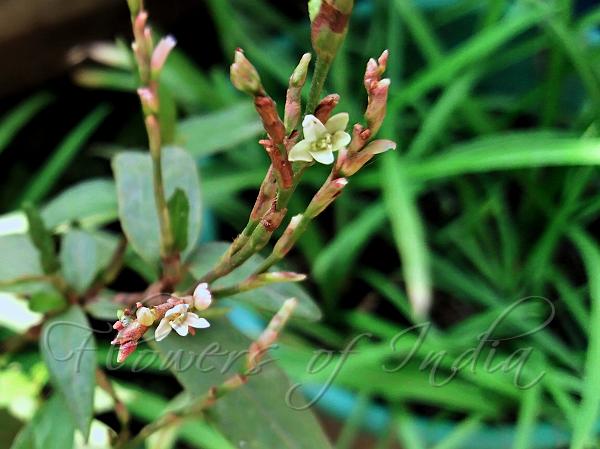|
| Creeping Himalayan Knotweed |
|

|

| File size | 699561 |
| Original date | 12/8/20 10:29 AM |
| Resolution | 3120 x 4160 |
| Flash | Flash did not fire, auto |
| Focal length | 3.47mm |
| Exposure time | 1/207s |
| Aperture | 2.2 |
| Focus Distance | |
| Metering Mode | Center weighted average |
| Camera make | OPPO |
| Camera model | OPPO A5 |
| Sensor type | OneChipColorArea |
|
|
|
|
Photo: |
Botanical name: Persicaria posumbu Family: Polygonaceae (Knotweed family)
Synonyms: Polygonum posumbu, Polygonum decumbens
Synonyms: Polygonum posumbu, Polygonum decumbens
Creeping Himalayan Knotweed is a very slender,
perennial herb, usually creeping below with rising up branches,
branches hairless, 25-30 cm high. Flowers are borne in a very slender,
interrupted, few flowered, thread-like raceme, at branch-ends or in
leaf-axils, 3-10 cm long, carried on almost equally long
flower-cluster-stalk. Ochreolae interrupted, 0.3-0.4 mm long, lax,
tubular, fringed with hairs at the mouth, cilia shorter than ochreolae.
Flowers are white or pink, nearly stalkless. Tepals are 5, in two
series, about 2.5 mm long, outer two are boat shaped, inner three flat,
oblong, blunt, eglandular. Stamens are 5-6, equal, filaments long,
anthers basifixed. Ovary is trigonous with 3 styles, stigmas capitate.
Leaves are stalked, leaf-stalk bristly hairy, up to 5 mm long, 2-12.5 x
0.5-1.8 cm, elliptic to elliptic-lanceshaped, entire, with pointed base
and with a tail to tapering tip, midrib, undersurface and margins
hairless to sparsely, bristlyly hairy. Ochreae tubular, sparingly
bristly, 0.5-1.0 cm long, fringed with hairs at the mouth, cilia stiff
equalling or slightly longer than the tube. Nut is trigonous, 2.0-2.5 x
1-1.5 mm, black, shining. Creeping Himalayan Knotweed is found in the
Himalayas to China and SE Asia. Flowering: May-October.
Medicinal uses: In Manipur, crushed leafy shoot is used for
local application on forehead against fever.
In Manipur, crushed leafy shoot is used for
local application on forehead against fever.
Medicinal uses:
 In Manipur, crushed leafy shoot is used for
local application on forehead against fever.
In Manipur, crushed leafy shoot is used for
local application on forehead against fever.
| Identification credit: Thingnam Girija | Photographed in Imphal, Manipur. |
• Is this flower misidentified? If yes,